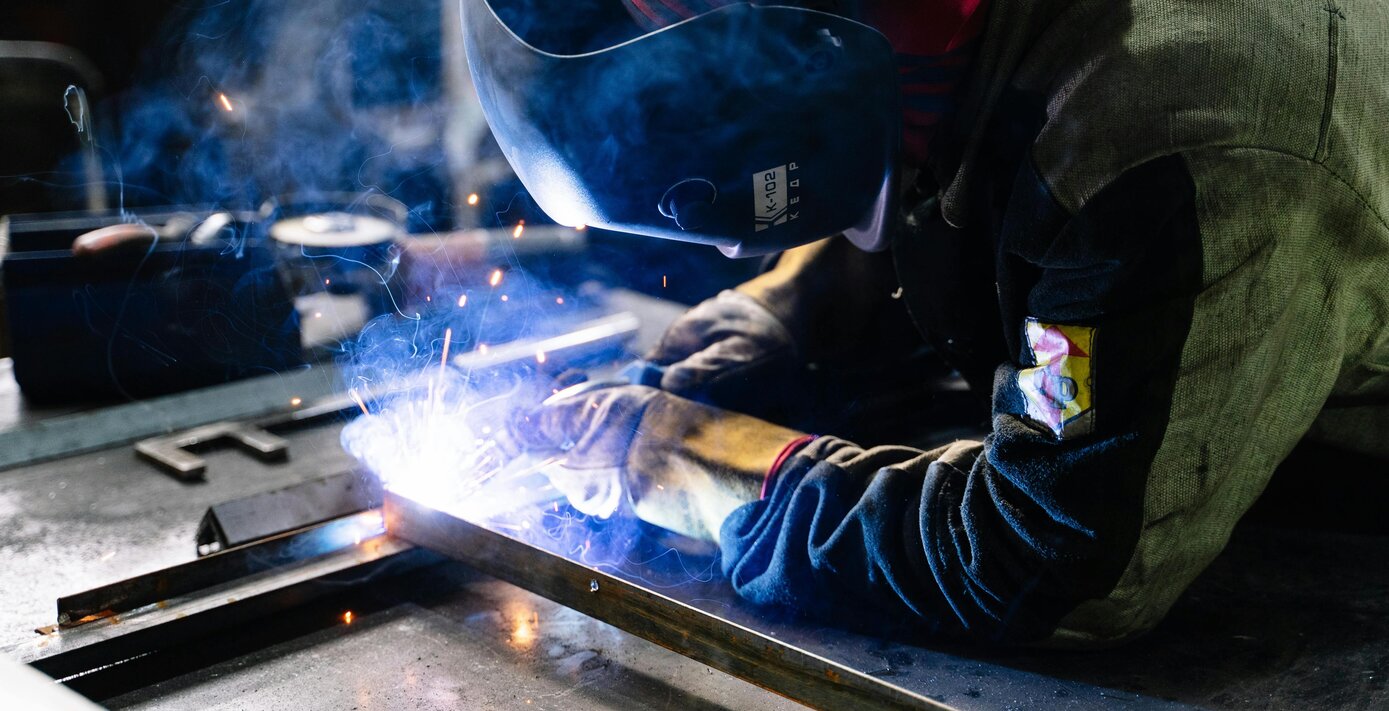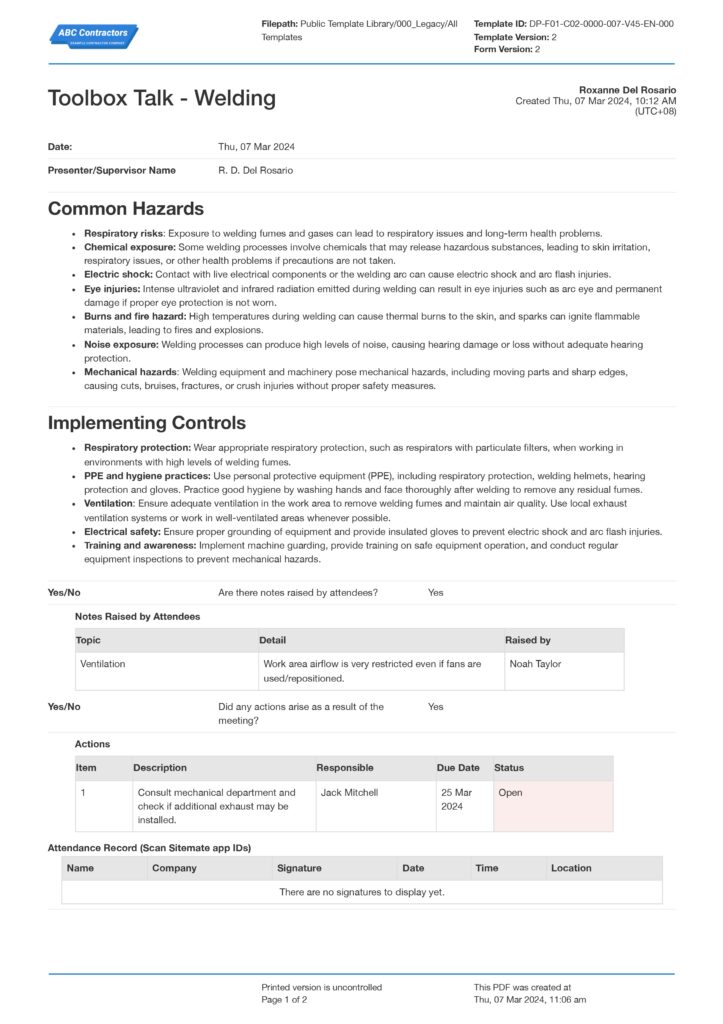Dashpivot Article – Welding Safety Precautions
Welding Safety Precautions
In this article, we cover the common and required safety precautions involved during welding activities to keep welders, workers and the broader workplace safe and operational.

Why are Welding Safety Precautions Necessary?
Welding has been an integral activity in many industries. It is a methodical activity that gives strong, durable, and cost-effective results when soldering metals and other materials. It was used since the beginning of the Bronze and Iron age. Ancient Egyptians used forged welding, where metals are heated and hammered together. In the 19th century, modern welding techniques were born and evolved ever since.
However, despite its usefulness in the industry, it brings along hazards that could potentially injure the operator and the people around it. Because of these hazards, proper safety measures and precautions are needed to be put into place to eliminate these risks.
Why is Welding Hazardous?
Welding is an activity that involves extreme heat that could incur burn injuries that could range from 2nd-degree burns to 3rd-degree burns. It also involves intense light that can blind the operators and the people in the vicinity. Welding also generates a volume of dangerous fumes that could harm the respiratory organs.
Furthermore, welding in some specific areas, like confined spaces, can double the risks of harming the person operating with its hazards.
Additionally, aside from being a hazard for people, it is also a fire hazard that has the potential to cause fires and destroy company assets and materials, which could really take a toll on a company financially. Explore welding safety hazards for a deeper understanding.
Welding Safety Precautions
People must be shielded from the risks associated with welding, and the proper safety measures must be implemented. Effective implementation of these measures is necessary to maintain a safe and healthy environment. This section of the article will help you understand why these safety precautions are necessary by giving you a thorough rundown of the crucial welding safety procedures. Here are the welding safety precautions
Personal Protective Equipment
The best line of defence during welding is personal protective equipment. When putting two metals or materials together, they act as an armour that welders may safely do the activity. The welding mask is one of the PPEs that need to be worn during welding. The operator's face is shielded from UV rays, arc light, sparks, and flying debris by this mask's darkened lenses and complete face cover. Additionally, to protect the operator from burns caused by sparks and UV rays, welding aprons, fire-resistant trousers, and gloves should be worn at all times. In some situations, such as when welding in tight areas or when using a high-noise welding process, respirators and ear protection are required, respectively. The goal of all of them is to completely protect the operator from any risks that may arise during welding.
Ventilation
The fumes released during welding might be toxic to your health. Carbon monoxide is an excellent illustration of a gas byproduct that welding generates and that may be hazardous to your health. The incomplete combustion of carbon-containing materials and shielding gases produces carbon monoxide, a colourless, odourless, and deadly gas. Headaches, nausea, and dyspnea are already common side effects of mild exposure. Long-term exposure to high concentrations may result in convulsions and brain damage, which can put a person in a coma. Investigate "What are the hazards of carbon monoxide?" to have a better grasp of the gas.
Appropriate ventilation must be used while welding in order to reduce exposure to harmful gases such as carbon monoxide. The act of bringing in clean, breathing air and getting rid of dangerous gases and airborne pollutants from the workspace is known as proper ventilation. This is particularly important while performing the welding operation in limited locations since gases might build up there. Some ventilation devices that may assist in controlling the quality of the air in your workplace include fume extractors, hoods, and suction arms.
Fire Safety Programme
Welding poses a risk of fire. It is clear that this activity has the potential to start fires since it uses a high temperature to melt two metals, which produces flying sparks. A fire safety programme must be developed to inform staff members of the correct protocols and preventative steps to avoid starting fires, protecting both your workers and your property. In order to prevent any combustible goods from being ignited by welding sparks, the programme should include explicit instructions on how to do appropriate housekeeping prior to the welding operation. Proper instructions on what to do in the event of a fire should also be included. Fires are less likely to occur when welding activities are incorporated into an established fire safety programme, and staff members are constantly prepared in case of an emergency.
Equipment Inspection
Inspection is the most effective method for determining whether or not a particular piece of machinery is still in excellent shape and is capable of performing at its highest level without breaking. It is important to do routine inspections on all pieces of equipment, and welding machines are one of those things. It is important to do routine inspections of welding equipment in order to protect the operator from potential dangers such as electrocution. Operators can be exposed to cables that are frayed, loose, or broken, which causes high-voltage shocks that might result in second- to third-degree burns. In addition to this, the machine will be inspected for any possible damage that might result in issues with its functionality. Malfunctioning welding machines pose a significant danger because they have the potential to cause the welding equipment to explode.
Controlled Access to Welding Area
It is crucial that only those with the necessary welding skills carry out the activity. Handling such equipment might be harmful if one lacks the necessary knowledge and skills. Unqualified personnel are more likely to make mistakes that might lead to negative outcomes, such as burns or malfunctioning welding equipment. Furthermore, it would be wise to restrict who has access to the welding activity area. Only field managers, fire watchers, and operators should be permitted to enter the area. This increases concentration and productivity while reducing the number of employees exposed to risks.
Awareness of Welding Safety Precautions
The welding safety precautions have been covered, and the only thing left to do is to impart this helpful information to your coworkers . Toolbox talks are the most effective way to communicate this kind of knowledge. Toolbox talks are brief, casual gatherings where the main topic is workplace safety. It is an open forum for discussing safety issues and enhancing the field's present safety protocols. A toolbox form has to be created in order to have a successful toolbox discussion. The form includes open spaces for workers to sign and voice issues, as well as a list of the objective subjects to be covered in order to ensure a smooth meeting structure. Check out the welding safety precaution toolbox talk example below.
Welding Safety precautions documentation

Use this welding safety toolbox talk for yourself
Effectively Maintaining Safety Precautions
Declaring these safety measures in the workplace would not be sufficient. It is necessary to take action to ensure that these safety measures are consistently used in the workplace and do not become a one-time event. Here's a guide on how to make sure these safety measures are always taken.
Regular Safety Audits
The most effective method of determining if safety procedures are still followed and applied is via audits. The purpose of these planned inspections of safety protocols and measures is to determine if they are consistently followed throughout the activity. Audits may also be used to find weaknesses in the safety protocols and practices that are in place. This allows for continued improvement of the processes and measures and offers more reliable safety precautions.
Trainings and Seminars
Having trainings and seminars regarding welding safety precautions enhances competency in your workers and provides them full awareness of the importance of these precautions. Hands-on training works on an individual’s skills and builds their confidence in following the correct safety steps and implementing the correct measures. This will also help employees spot hazards more efficiently, which they can raise as a concern soon to further enhancing these measures and steps.
Open Communication Channels
It is highly recommendable to keep an open channel on safety concerns and issues. Providing a space where employees voice out their concerns with regards to their safety encourages hazard reporting. When hazards are reported, this will facilitate feedback and provide apprpriate solutions. With this kind of system , it will encourage workers to be more engaged and develop a safety initiative to keep the workplace safe and healthy.With this kind of system , it will encourage workers to be more engaged and develop a safety initiative to keep the workplace safe and healthy.
Streamlining Smart Welding Safety Precautions Awareness
Hand-made toolbox talks may be somewhat demanding. Since these are merely quick, informal encounters, the constant reformatting and printing may be a little disruptive. Moreover, developing the toolbox and entering the data into it call for opening many applications—including office ones—which takes time and increases the risk of mistakes.
Luckily, you now have an app that simplifies everything. Right immediately, you will start utilising the Dashpivot Toolbox app with a digital toolbox discussion form produced either from a potent form builder or a free toolbox conversation template from our template library. employing topic tables, date pickers, digital hand signatures, or totally contactless signatures can help you to optimise your toolbox discussion form by removing the need of continually printing forms and employing so many apps to convert them. Dashpivot lets you stop worrying about the internet only to fill a digital file. Starting the Toolbox Talk app right on the field offline may be your approach. Any of your ready-made or completed toolbox lectures may also be rapidly located, altered, or converted into a professionally created PDF document online, where they are automatically maintained and arranged once you have supplied content and conversation themes.
All of these and more by use of the Dashpivot Toolbox App. Click this link here to learn further: Dashpivot Toolbox Talk App.

Fire door inspection
Keep up-to-date with fire door inspections around welding zones

Fire inspection report
Conduct and store fire inspection reports using this form

Welding SWMS
Use this welding specific safe work method statement to document high risk welds

